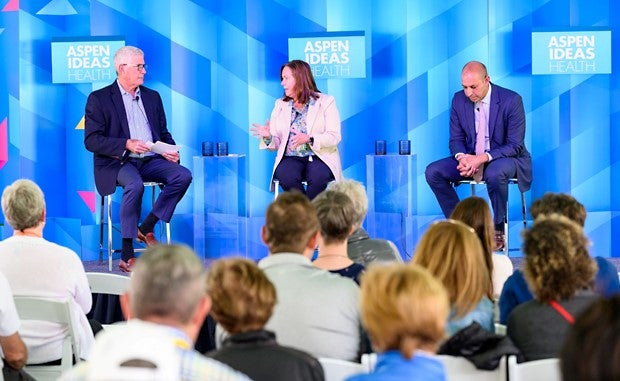

3 Big Ideas from Aspen Conference to Transform Health Care

The growing workforce crisis has brought disruption to the health care landscape, but evolving care models and technological advances show promise for reshaping the field.
Nearly 1,000 health care leaders and change-makers recently convened at Aspen Ideas: Health, part of the Aspen Institute’s Aspen Ideas Festival, to explore health care’s biggest challenges and debate possible solutions. An AHA panel discussing “The Hospital of the Future: Transforming Care Delivery,” explored how to turn ideas into action and create pathways toward better health for all.
Here Are Three Ideas That Stood Out
1 | Patients reach your digital front door earlier than you think.
Many hospitals and health systems have increased their attention to the digital front door — a term that encompasses the various, digitally enabled ways a patient might access care. Efforts are underway at many organizations to enable and ease booking online appointments or other information that helps direct patients to the right care at the right time.
While these are important improvements that expand access and increase convenience, three-quarters of all people search the internet for health information before entering the health care system, said Karen DeSalvo, M.D., Google’s chief health officer.
The most successful health care providers recognize the opportunity to move patients from “Dr. Google” to the appropriate care site in a seamless way.
2 | Embrace the robots.
Robotics in health care have been around for decades, but the next generation of robots and cobots, or collaborative robots, on display at the festival showed great promise for solving problems facing both patients and clinicians.
Pepper, a robot developed at a University of Minnesota-Duluth (UMD) lab, helps elderly patients with social and cognitive engagement. Arshia Khan, UMD computer science professor, and her students programmed the robot to serve as a personal, caregiver assistant for people with Alzheimer’s disease or other forms of dementia.
Pepper loves a good conversation and even tells jokes — a top request among residents in the nursing home where she was first tested. The robot is equipped with camera sensors that allow it to detect a patient’s facial expressions, voice tone and physical movements. It is programmed to guide patients through reminiscence therapy and can teach yoga and tai chi.
ChrisitianaCare is piloting a cobot called Moxi that works alongside nurses to take on tasks that can be automated, such as fetching supplies. Designed by two robotics experts at Diligent Robotics, Moxi is the first in-production robot that uses artificial intelligence and continuously adapts to changes in hospital workflows by learning from the humans with whom it interacts. After just seven weeks, the two Moxis deployed at ChristianaCare have saved nurses an estimated 600 hours of work, said Janice Nevin, M.D., MPH, president and CEO.
While the deployment of robots to aid patients or staff is in its early phases, the use cases illustrate the possibility of augmenting the strained health care workforce while freeing up humans to practice at the top of their licenses.
3 | Replace transactional care with longitudinal relationships.
Current health care delivery modes are “fundamentally designed to capture failures of chronic care,” said Omar Lateef, D.O., president and CEO, Rush and Rush University Medical Center, at an AHA-convened panel on the future of care delivery. Instead, care should be reimbursed based on outcomes and preventing the exacerbation of chronic disease.
To achieve that model of care, clinicians — and the entire ecosystem around them — would focus first on human-to-human relationships over time and not on “visits.” Technology could support and enhance those relationships but, first and foremost, value must be placed on the relationship between patient and provider.
Through these relationships — and aided by tech — patients could better navigate available resources to address the social determinants that impact their overall health more significantly than clinical care.



